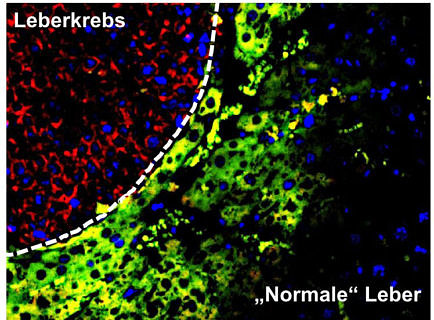Unlocking new mechanisms behind liver cancer

Walter-Siegenthaler-Gesellschaft awards prize to FAU researcher
Liver cancer is a particularly aggressive type of cancer which kills approximately 800,000 people throughout the world every year. In Germany alone, more than 9,000 new cases of liver cancer are diagnosed per year. This makes it one of the deadliest cancers. An interdisciplinary research team at FAU and Universitätsklinikum Erlangen (UKER) have unlocked a mechanism in which liver cancer cells take a substance formed by benign liver cells and use it for their malignant growth.
In recognition of this fundamental work, the Walter-Siegenthaler-Gesellschaft für Fortschritte in der Inneren Medizin (Walter Siegenthaler Society for Progress in Internal Medicine) has awarded the lead author of the study, Dr. Peter Dietrich, from the Department of Medicine 1– Gastroenterology, Pneumology and Endocrinology at UKER and Chair of Biochemistry and Molecular Medicine at FAU, their Science Award 2020. The researchers have published the results of the study in the Journal of Clinical Investigation.
Liver cancer usually begins once the liver is already damaged, in patients suffering from a condition known as cirrhosis. This develops, for example, after many years of drinking too much alcohol or as a result of chronic viral hepatitis. An interdisciplinary team of researchers at FAU and UKER have now succeeded in uncovering a mechanism which makes a key contribution to the malignant properties of liver cancer cells. A crucial role is played by the short-chained protein molecule neuropeptide Y (NPY), which is normally formed in nerve fibres and connects the nervous system to various organs and the immune system. NPY is involved, for example, in appetite regulation as well as in regulating immune responses in the event of inflammation.
NPY receptors
NPY works on various types of cells via receptors, which are located on the surface of the cell like aerials and transmit signals to the interior of the cells. The current study shows that large numbers of these NPY receptors are located on the surface of liver cancer cells. When NPY attaches to the receptors, it activates them and this can lead to an accelerated growth of cancer cells and cause metastasis. In animal models, using specific drugs to inhibit the NPY receptors proved an effective way to significantly slow the growth of liver tumours.
Attractant for liver cancer cells
It is only the benign liver cells surrounding the tumour which form NPY, not the liver cancer cells themselves. The growth of malignant cancer cells causes inflammatory substances to be produced which in turn encourage normal liver cells to produce large quantities of NPY. As NPY is produced outside the tumour but the tumour cells have a great many NPY receptors, NPY acts like an attractant which causes cancer cells to be released into the surroundings, thereby contributing to metastasis.
Diabetes medicine may slow growth of liver cancer
The team of researchers were able to demonstrate that a special protein molecule known as dipeptidyl peptidase 4 (DPP4) which is produced in increased quantities by liver cancer cells can lead to an even higher level of activation of NPY receptors. Inhibitors known as gliptins which are already used against DPP4 as a treatment for diabetes could be used to weaken the activation of NPY receptors on cancer cells. In future, this property could be used to develop medicine aimed at combating this behaviour in liver cancer cells.
Walter-Siegenthaler-Gesellschaft für Fortschritte in der Inneren Medizin
The mission of the Walter-Siegenthaler-Gesellschaft für Fortschritte in der Inneren Medizin is to encourage clinical and scientific findings in internal medicine. The society awards the silver Walter Siegenthaler medal for fundamental scientific work on current topics relating to internal medicine. This year, the prize committee recognised the work of the team of researchers from Erlangen by awarding the renowned Walter Siegenthaler silver medal to Dr. Peter Dietrich. Due to the coronavirus pandemic, the medal and prize money will officially be awarded to Dr. Dietrich during a symposium of the Walter Siegenthaler Gesellschaft in 2021.
Further information
DOI: 10.1172/JCI131919
Department of Medicine 1– Gastroenterology, Pneumology and Endocrinology
peter.dietrich@uk-erlangen.de